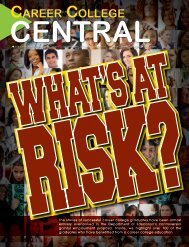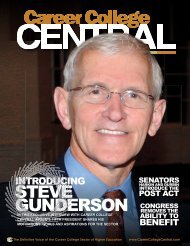Forward
Check out our latest edition online - Career College Central
Check out our latest edition online - Career College Central
- No tags were found...
You also want an ePaper? Increase the reach of your titles
YUMPU automatically turns print PDFs into web optimized ePapers that Google loves.
“Campuses need to consistently explain how they fit intopostsecondary education in their state,” Wilson said. “So manypeople in places of authority do not consider us part of thepostsecondary fabric of education.”Chris Hoehn-Saric, Senior Managing Director of SterlingPartners, discussed how to build an institution that is relevant,profitable and competitive. Hoehn-Saric began his presentationby telling the audience that he was part of a group of collegebuddies who eventually began investing in higher educationventures. One of his many accomplishments involvedtransforming Sylvan Learning Systems into a successful andthriving educational services company. Hoehn-Saric offeredseveral critical suggestions to help institutions lead the strategicplanning process and discussed the evolving landscape of careereducation.“About three years ago, it became clear that the underlying growthcharacteristics of the sector were not going to be as favorable,”Hoehn-Saric said. “We know about tuition trends and lendingand sort of the effect of that side of the world, but ultimately themarket has stalled.”Gunderson, who recently published The New Middle Class: CreatingWealth, Wages and Opportunity in the 21st Century, spoke about thevalue career colleges will have on our nation as it struggles withissues of class.“We are a nation seeking a new road map for the new middle class,”Gunderson said. “We see our sector as the bridge between educationand employment.”Higher education has seen a reduction of enrollment for two yearsstraight, which is something that has never occurred, Hoehn-Saricsaid. But he said he expects those numbers to recover, though notquite to the numbers of previous decades.Whatever the future holds – whatever direction the currentregulatory measures facing the sector take – those trends willbe diagnosed and likely resolved at the next EDU MarketingSummit.Gunderson’s presentation was followed by a CEO panel, whichconsisted of Dr. Arthur Keiser, Chancellor and CEO, KeiserUniversity; Shaun McAlmont, President and CEO, LincolnEducational Services; and Jim Haga, CEO, Education ServicePartners. The panel addressed trends in enrollment, retention andcompletion, and the future of career education. The current regulatoryenvironment and negative outlook on for-profit education has madethe role of CEO challenging, Keiser said, but he finds motivationfrom a critical source.“When I see the students who have graduated, when I see the studentswho are successful, it motivates me and keeps me going,” Keisersaid. “It has been a difficult period of time in the last few years.Though I still see the role that we play is critical to the future of thiscountry, critical to the future of working-class people throughout theUnited States, and I am pleased to be part of it.”Public perception of the career college sector as a whole can colorviews of individual campuses, said Michele Wilson, Director ofCorporate Outreach, Center for Excellence in Higher Education.Wilson hosted an insightful session on how schools can take theircommunity outreach to the next level. Her presentation describedhow colleges can develop a positive regulatory bias, which involveschanging perceptions in state capitols.Kevin Kuzma is Editor of Career College Central.His feature writing, essays and short stories haveappeared in The Kansas City Star, Urban Times,Review, Ink Magazine and Present Magazine. He canbe contacted at kevink@careercollegecentral.com.




